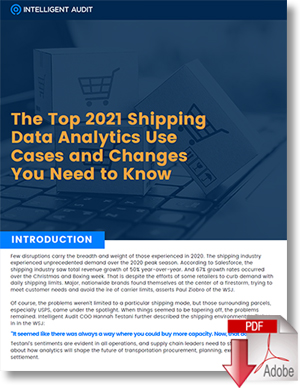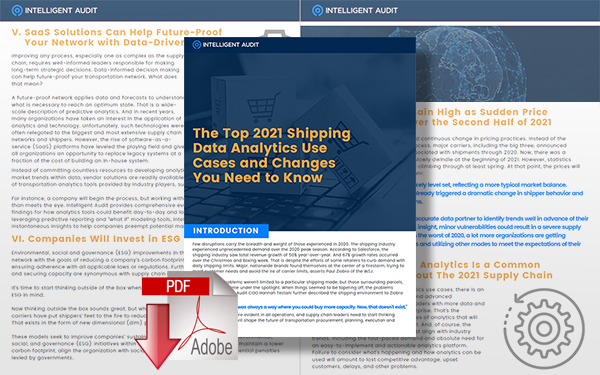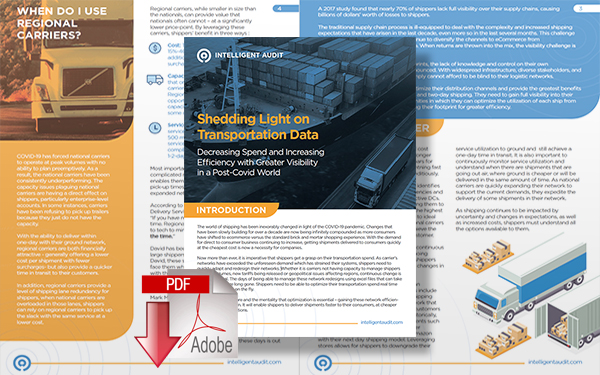Key Performance Indicators for the Freight Shipping Industry

Logistics spend management remains a critical process for all shippers, but it remains subject to errors that often derive from the sheer diversity of modes, especially when the parcel is involved - this article details the key performance indicators necessary for the freight shipping industry.
Logistics Spend Management
Logistics spend management remains a critical process for all shippers, but it remains subject to errors that often derive from the sheer diversity of modes, especially when the parcel is involved, within the space.
And according to a fall 2020 study on invoicing practices, says JOC.com;
“approximately three-quarters of survey respondents manage freight for companies with more than $1 billion in revenue, including nearly 40 percent from companies with more than $5 billion in revenue. Sixty-five percent of shippers surveyed said they manage freight across all seven modes analyzed in the study: full container load, less-than-container load, truckload, less-than-truckload, parcel, drayage, and rail.”
That’s a tall order of data analytics, but it’s important to realize that much of it amounts to parcel and e-commerce logistics.
For that reason, it’s imperative for shippers to start tracking the right data metrics in the form of these critical key performance indicators for the shipping industry.
Average & Running Monthly Spend
Tracking the average and running monthly transportation spend is among the most critical key performance indicators for the shipping industry.
It helps managers view and mitigates disruptions by drilling down into specific service levels, carriers or markets to avoid going over the budget. Seeing those trends also helps to promote more efficient management and effective carrier compliance too.
On-Time Pickup
Another critical metric, on-time pickup amounts to viewing carrier reliability and the ability of a shipper to get shipments out the door.
It’s a measure of carrier timeliness, and knowing when carriers fall into an unacceptable on-time pickup range helps denote those problems early on and provide feedback to those carriers in question. Moreover, this is a vital factor in annual contract negotiations too.
On-Time Delivery
On-time delivery is yet another carrier metric that amounts to the overall success of logistics.
And it is largely reliant on the on-time pickup rate. If the delivery service level fails, it becomes evident that a carrier cannot meet realistic pickup or delivery expectations. In turn, that means notifying customers of possible delays or resetting standards for delivery windows. In addition, it may be pertinent to use this data to justify expanding the carrier network or revoking existing contracts.
Zone Distribution
Among the key performance indicators for the shipping industry, tracking zone distribution measures experience and logistics costs. As the zone increases, the distance for transport and its coinciding costs increase as well. Recognizing variations amounts to reassessing current distribution strategies, such as implementing or creating new distribution centers closer to customers. And it may also include added value by helping create a mix of modes to reduce delays and avoid waste.
Average Cost Per Shipment & Per Pound
The next two key performance indicators are relatively simple. They are the average post per shipment and per pound. These views help shippers identify their typical costs per shipment, see deviations that fall outside of the normal run rate, and identify their causes. As such, it also helps with retooling shipping strategies, including justifying costs that are passed along to customers in the form of higher price points or shipping costs assessed.
Weight Distribution
Weight distribution, another of the key performance indicators for the shipping industry, helps shippers realize what’s happening and apply data to understand how carriers view and analyze their business. The fluctuations in cost per package and per pound amount to predictive insight into what’s driving current logistics spend.
Packaging and Dimensional Weight
Dimensional pricing (dim pricing) is another factor to consider. While a package may weigh a set amount, excess space or bulky items may have a larger dimensional weight. In general, the highest weight is the billed weight. So, tracking the changes in dimensional weight versus actual weight helps to maximize cost savings and possibly send parcels to alternate carriers with better dim factors.
Approved Carrier/Service Routing
Another metric is approved carrier and service routing. This is a simple metric for tracking whether your shipping department or vendor’s shipping on your behalf adheres to the prescribed route to reduce total transportation time and use the right carrier. Often, it’s more valuable for shippers as a tool for measuring compliance across multiple carriers than a single, partnered carrier.
Freight Invoice Accuracy
And the last of the key performance indicators for the shipping industry is perhaps the most important - freight invoice accuracy. It’s a ratio of the total invoices free of errors compared to the total invoices. If carriers continuously exhibit a low accuracy rating, it coincides with unnecessary and costly changes to the budget. Duplicates, incorrect classes, accessorial errors, and subpar ratings can affect invoice accuracy. Regardless, the key is to stay positive, look for the highest performing carriers based on invoice accuracy, and build on those relationships.
Start Tracking the Right Key Performance Indicators for the Shipping Industry With Intelligent Audit
These are only a fraction of the possible key performance indicators that the shipping industry could help your enterprise thrive. Start by getting access to the data you need for advanced analytics. And continue by normalizing data from within and beyond your company.
Fortunately, vendors like Intelligent Audit have already taken those steps for you. They are ready to help your company put the power of the top key performance indicators for the shipping industry to work in your enterprise.
Connect with Intelligent Audit to get started.
Related Resources
2021 Shipping Data Analytics Use Cases and Changes You Need To Know
This white paper describes the importance of knowing the 2021 shipping data analytics use cases and why they are becoming increasingly important to freight shippers. Download Now!
Shedding Light on Transportation Data
This eBook explores how shippers can gain network efficiencies, enabling shippers to deliver shipments faster to their consumers, at a lower cost with fewer exceptions. Download Now!
More Resources on Key Performance Indicators
Article Topics
Intelligent Audit News & Resources
UPS Peak Surcharges Set to Increase on June 13, 2021 2021 Shipping Data Analytics Use Cases and Changes You Need To Know Hannah Testani Named as CEO at Intelligent Audit and Adds to Executive Team Key Performance Indicators for the Freight Shipping Industry Shedding Light on Transportation DataLatest in Transportation
Trucking Industry Pushes Back on Government’s Electric Mandates Maersk Sees Silver Lining in Red Sea Shipping Challenges Baltimore Opens 45-Foot Deep Channel Following Bridge Collapse El Paso Border Delays Cost Juarez $32 Million Per Day in Economic Losses Ranking the World’s 10 Biggest Supply Chains The Top 10 Risks Facing Supply Chain Professionals Walmart’s Latest Service: Ultra Late-Night Delivery More Transportation
















